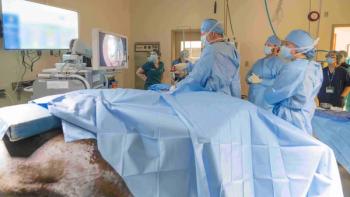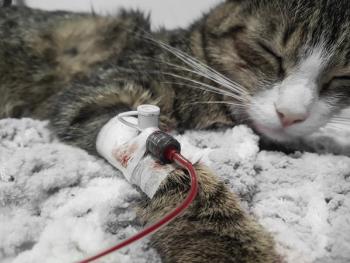
Surgery STAT: Tightrope CCL for treating canine cranial cruciate deficiency
Treatment of cranial cruciate ligament deficiency is the most common surgical procedure performed in veterinary orthopedics.
Treatment of cranial cruciate ligament (CCL) deficiency is the most common surgical procedure performed in veterinary orthopedics. While numerous techniques have been investigated, there is no perfect procedure in terms of balancing safety and efficacy for patients, and no technique has been proven superior to others in terms of functional outcomes.
The Tightrope CCL technique was developed in hopes of addressing some of the perceived shortcomings of others, with reduction of complication rate and severity as the primary priority.
The Tightrope CCL technique is based on the lateral retinacular imbrication suture (LRIS) principle. The theorized advantages of the Tightrope (TR) over the LRIS include bone fixation at both tibial and femoral attachments, more accurate isometric placement, minimally invasive capabilities and the strength, stiffness and creep characteristics of the implant.
Because the TR technique helps ensure optimal isometric placement, counteraction of abnormal cranial drawer and thrust and internal rotation with maintenance of stifle range of motion can be accomplished and maintained in the long term.
The technique involves complete evaluation and treatment of intra-articular structures, either via arthrotomy or arthroscopy, as indicated for comprehensive surgical management of CCL disease.
The joint is lavaged and closed if arthrotomy is done. The lateral aspect of the stifle is then exposed to the level of the joint capsule from lateral fabella to tubercle of Gerdy (accomplished through the approach for arthrotomy or a separate incision after arthroscopy).
The femoral and tibial tunnels are created for the Tightrope CCL by first placing k-wires (to ensure accurate tunnel location) followed by drilling with a cannulated drill bit over the wires.
The femoral tunnel extends from a point in the caudal aspect of the lateral femoral condyle just distal and cranial to the lateral fabella to the medial aspect of the distal femoral diaphysis just caudal to the vastus medialis at the level of the proximal pole of the patella.
Photos 1 and 2: Cranial (left) and lateral views of the tifle, showing placement of the Tightrope CCL device. (ILLUSTRATIONS: COURTESY OF DR. JAMES COOK)
The tibial tunnel extends from the most proximal aspect of the muscular groove of the lateral tibia deep to the long digital extensor tendon to the medial aspect of the proximal tibia. The Tightrope CCL (fiber tape with toggle and button) is then placed through the tunnels and secured to stabilize the stifle (Photos 1 and 2). Standard closure is then performed.
The Tightrope CCL was tested mechanically and in cadavers prior to clinical use. The first clinical patients treated (about three years ago) were compared to patients treated with TPLO in a prospective head–to-head study. As evaluated in that clinical study, Tightrope had equivalent functional outcomes at six months with a better safety profile.
Multicenter data compiled thus far suggests the Tightrope CCL can be performed successfully in medium, large and giant-breed dogs with CCL deficiency. Furthermore, in the ongoing multicenter study, 95 percent "good" to "excellent" outcomes are being consistently reported with less than 9 percent complications requiring additional treatment.
EDITOR'S NOTE: SurgerySTAT is a collaborative column between the American College of Veterinary Surgeons (ACVS) and DVM Newsmagazine. This month, James (Jimi) Cook, DVM, PhD, Dipl. ACVS, writes about the most common surgical procedure performed in veterinary orthopedics, the treatment of cranial cruciate ligament (CCL) deficiency. Next month, Catriona MacPhail, DVM, PhD, Dipl ACVS, writes about treatment options for feline inflammatory polyps. Dr. MacPhail is currently on faculty at Colorado State University as a soft-tissue surgeon. Her primary clinical and research interests include upper and lower respiratory disease, wound management and reconstruction, gastrointestinal surgery and minimally invasive surgery.
Dr. James (Jimi) Cook's clinical interests are in arthroscopy, minimally invasive orthopaedic surgery, orthopaedic tissue engineering, cartilage repair and management of osteoarthritis. He currently has a dual appointment at the University of Missouri in Small Animal Orthopaedics and Orthopaedic Surgery (human), and is the director of the Comparative Orthopaedic Laboratory and the William & Kathryn Allen Distinguished Professor in Orthopaedic Surgery.
Newsletter
From exam room tips to practice management insights, get trusted veterinary news delivered straight to your inbox—subscribe to dvm360.




